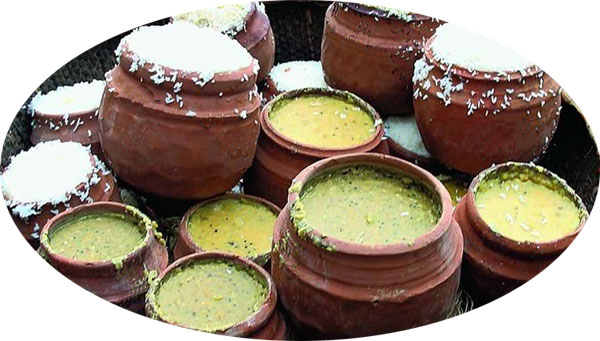

Loading Section...
Everyday throughout the year fifty six varieties of dishes are prepared and offered to the Deities of the Jagannath Temple. These consist of preparation of rice, dal and other selected vegetables. The food is cooked in accordance with prescribed procedures, and is offered first to Lord Jagannath and then to Goddess Bimala after which it turns into Mahaprasad. Mahaprasad, the holy food, is freely shared by people of all castes and creeds without any discrimination. In all religious and social rituals in Puri and Odisha, Mahaprasad plays a very important role. Exchange of Mahaprasad between two persons belonging to two different castes binds them in an abiding relationship. Mahaprasad and other offerings made to the deities are sold to public in Ananda Bazaar on the north-east corner of the outer enclosure of the Jagannath temple, where every day thousands of piligrims buy and eat various types of food.
There are four abodes of Hindu Gods located in the four directions of the Indian sub-continent. They are known as Çhar Dhams and considered as the most sacred sites for Hindus. The Char Dham consists of four sites - to the north is Badrinath, to the west is Dwarka, to the south is Rameshwaram and to the east is Puri. Puri is also popularly known as the Jagannath Dham. All the four holy abodes are believed to have been liked by Lord Vishnu intimately. It is said and believed that Lord Vishnu takes His bath at Rameswaram, meditates at Badrinath, dines at Puri and finally retires at Dwarika. Therefore, a lot of importance is given to the Mahaprasad of Puri Jagannath temple.

Mahaprasad is cooked only in earthen pots inside the temple kitchen and medium of food is fire wood only. Mahaprasad can only be eaten on banana leaf while sitting on the floor. In most temples in India, the food that has been offered to the Deities is called as 'Prasad', but only in Lord Jagannath temple the food that has been offered is called 'MahaPrasad'. In Odia language 'Maha' means 'Great', so the word 'MahaPrasad' itself depicts the sagacity of greatness.
Dried rice Mahaprasad known as 'Nirmalya' is also used by devotees for different sacred occasions. Nirmalya is equally important as Mahaprasad. It is also believed by Hindus that at the time of death, the Nirmalya and holy basil (Tulsi) with water is poured in the tongue and throat of the imminent deceased persons with the belief that by taking these items after their death their soul will remain in peace and there will be no 'Jamadanda' (Punishment by death God) of the Belzibup. Tourists visiting Puri prefer to carry this dry Mahaprasad with them which they can keep at home and consume whenever required.
Every day throughout the year millions of devotees from around the world visit Jagannath temple to get the divine blessings of Lord Jagannath, the Lord of the Universe. It is believed that both Lord Jagannath and the Mahaprasad share an equal status. Sharing the Mahaprasad is considered as a blessing through which devotees get salvation from their sins. Therefore the visit to the Lord Jagannath temple is incomplete without having the Mahaprasad.
Types of Mahaprasad:
There are two types of Mahaprasad. They are Sankhudi Mahaprasad and Sukhila Mahaprasad. Both the types are available for sale in Ananda Bazaar of the Lord Jagannath temple.


Why Sankhudi Mahaprasad is also known as Abhada?
In Odia language the term 'Badha' means 'something that is servered' and 'A-badha' means 'something that is NOT served'. The Sankhhudi Mahaprasad that has been offered to the Deities is in the form where the entire cooked food along with the earthen pot is offered without parting it. All the earthen pots with the cooked food are carried from the temple kitchen to the Bhoga Mandapa (offering hall) and offered to the Deities, that's why it is called Abadha'.


What is Kotha Bhoga and Baradi Bhoga?
In local Odia language the offering to the Deities is known as ‘Bhoga’. The Mahaprasad preparation in the kitchen are categorized into two parts, Kotha Bhoga & Baradi Bhoga.
Follow below rules while partaking Mahaprasada
This is very important to follow below rules while distributing and consuming Mahaprasada. These rules are a mark of respect to the Lord and His Holy Mahaprasada.
Why Mahaprasad is always served on banana leaf and eaten while sitting on the floor?


Did You Know?
When the cooked food is carried to the offering hall in slings of earthen pots no flavor comes up from the food but when the same is offered to Lord Jagannath and Goddess Bimala and carried back to Ananda Bazzar (the sale point), a delicious smell spells along in the breeze to the pleasant surprise of the devotees. Now the food is blessed.
Did You Know?
| Content Navigation | ||
| Next Page | ||
|
Loading Section...
Loading Section...